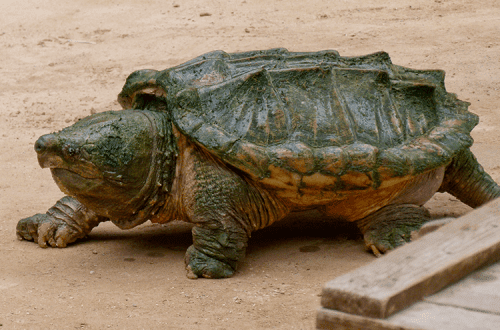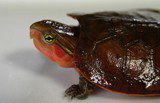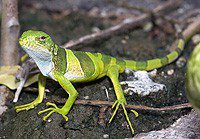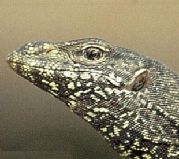
Bengal monitor lizard
Bengal monitor lizard (Varanus bengalensis) is a reptile that has a body size of up to 2 meters, as a rule, on average it does not exceed 170 cm. These animals have a slender body and a narrow, noticeably pointed head in front. Their tail is of moderate length, laterally compressed and has a low double keel along its upper edge. The body of monitor lizards is dark olive in color, covered on top with numerous speckles and round yellow spots. They are transverse lines. Adult representatives of this species are uniformly colored yellow, brownish-olive or brownish-gray, on which dark spots are barely distinguishable.
Inhabitation
The Bengal monitor lives in a territory that stretches from Ceylon, India, Nepal, Pakistan and Burma to Indo-China, the Malay Peninsula and the Philippines in the east, and extends south through all of Indonesia to the Lesser Sunda Islands.
Life in nature
 In nature, the Bengal monitor is less associated with water than other monitor species, and is often found in dry and arid areas. These animals can settle in forests, gardens, various plantations, thickets and near human buildings.
In nature, the Bengal monitor is less associated with water than other monitor species, and is often found in dry and arid areas. These animals can settle in forests, gardens, various plantations, thickets and near human buildings.
In the presence of water, the reptile enters there with great pleasure, stands in it for a long time and can even swim a short distance.
The Bengal monitor, like almost all animals, has a shelter from enemies, bad weather and just a place where he can rest in peace. They have deep burrows for lizards, which they dig under large stones or tree roots, and they can also live in tree hollows. It is not a problem for monitor lizards to get into them, since these animals climb trees perfectly, clinging to the bark with their long claws.
On a flat surface, the Bengal monitor lizard runs quite well, while taking big steps, lifting its tail high. When danger arises and there is no way to hide from it, the reptile pretends to be dead and remains motionless, even when it is lifted by the tail. The monitor lizard is able to jump from a height of 10-15 meters without harm to its health.
In the north of its habitat in Pakistan, the Bengal monitor hibernates for the winter in the presence of adverse climatic conditions.
These animals lead a predatory lifestyle, feeding on insects, lizards, small mammals, birds and eggs.
Content at home
Keeping a Bengal monitor at home requires a spacious terrarium, as the animal will grow up and should not be limited in space. Of course, it is desirable that for an adult animal the area be at least 6 square meters. When starting such an animal, you must be clearly aware that it is a predator and you will need to feed it, almost always, with living organisms. Therefore, if you cannot do this, then the Bengal monitor is not your choice.
As with all reptiles, this monitor lizard needs two temperature zones in a terrarium. The daytime temperature should be kept around 35°C in the heating area and around 25°C in the cool area. At night it should be 25°C and 20°C respectively. You also need an ultraviolet lamp specifically for reptiles. The best soil for them will be plastic artificial turf with a pile height of 2 mm. It is easy to remove all kinds of pollution from it and it will not cause injuries and health problems to the animal. Also in the terrarium, you need to install snags and a stone on which the animal will lie. The monitor lizard should always have water in a container from which it can drink and in which it is easy to completely submerge.
Feeding the Bengal monitor lizard at home is carried out with the same products that he would consume while in the wild, that is, mice, large insects, frogs, lizards, eggs, and the like. The main thing is that his diet should be varied and nutritious, otherwise the animal may have health problems.
Reproduction
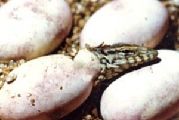 During the mating season, male Bengal monitor lizards become very aggressive and arrange fierce fights among themselves. Both opponents stand almost vertically, lifting their bodies up, grab each other with their sharp claws, and with open mouths try to grab each other by the neck and knock them to the ground. At the same time, animals breathe very often, in tense moments of the battle, uttering an intrauterine roar. During the fight, the males forcefully plunge their claws into the opponent’s body, leaving bleeding wounds. After one of the animals knocked down the other, the fight continues on the ground, and after a short time one of the monitor lizards gives up and hastily runs away from the battlefield. The winning male mates with the female.
During the mating season, male Bengal monitor lizards become very aggressive and arrange fierce fights among themselves. Both opponents stand almost vertically, lifting their bodies up, grab each other with their sharp claws, and with open mouths try to grab each other by the neck and knock them to the ground. At the same time, animals breathe very often, in tense moments of the battle, uttering an intrauterine roar. During the fight, the males forcefully plunge their claws into the opponent’s body, leaving bleeding wounds. After one of the animals knocked down the other, the fight continues on the ground, and after a short time one of the monitor lizards gives up and hastily runs away from the battlefield. The winning male mates with the female.
Egg laying in natural habitat occurs from December to April. The female digs a goblet-shaped hole up to 30 cm deep in the ground, after which she lowers her back part of her body into it and stays in this position for about 3 hours, after which about 30 laid eggs remain in the hole. After that, the animal digs the hole back with its front paws and levels the ground. After 5.5 months, fully formed offspring hatch into the world. It gets out of the nest along the general course, which was dug by the first cub that got out to the surface.



